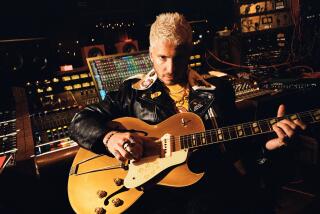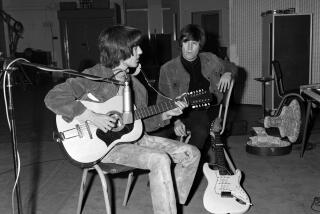Instruments Known for Quality, Unusual Shapes : Guitar Maker Carves His Design on Pop Music
- Share via
Hoyt Axton, the prototypical big-bellied, hard-living country-western singer, leaned over a small workbench and eyed Danny Ferrington, who is a half-foot shorter and a hundred pounds lighter.
“You know,” Axton said in his deep, slow Oklahoma way, “you’re the most expensive male friend I’ve got.”
Ferrington laughed. He can afford to. He has people like Axton paying him thousands of dollars for the pleasure of self-indulgence.
There he sits inside a second-floor loft in an industrial section of Santa Monica, a place without a phone--heck, without a stairway some days--burying himself in an intimate dialogue with slabs of spruce and rosewood.
Calvin Klein of Guitars
Ferrington, an enthusiastic, irreverent man who says his goal is to be the Calvin Klein of guitars, is establishing himself as designer to some of the more adventurous stars of rock ‘n’ roll and country music. For $2,000 to $3,000, he crafts instruments whose design shatters the mold of centuries.
Traditional, comfortable curves are replaced by jarring angles and unexpected twists. The color may be determined by something as whimsical as a singer’s favorite lipstick. The wood may be chiseled, lacquered and painted to resemble the jagged frame of the acoustic guitar’s bitter rival, the electric guitar. The elaborate mother-of-pearl trim that Ferrington cuts with a jeweler’s saw and lays into the wood may duplicate the heart-and-crossbones tattoo on one star’s arm or highlight memorable dates in another’s life.
Or, as in the case of a guitar Ferrington built for Axton in 1979 in Nashville, even more esoteric combinations may arise.
Axton wanted the neck of his guitar to be lined with a “tree of life” design he had seen on a turn-of-the-century folk guitar. (“I love that fancy stuff that glitters.”) Using mother-of-pearl and abalone, Ferrington fashioned 16 angels and assorted other figures.
Axton also wanted a buffalo at the base of the instrument. Not just any buffalo, but, as he put it, “an anatomically correct albino buffalo.”
The buffalo must have had deep symbolic meaning, a visitor suggested recently when Axton came from Lake Tahoe to see Ferrington. “Well, it did at the time,” Axton said. “I can’t remember what it was.”
Ferrington, 32, the son of a Louisiana cabinet-shop owner, grew up enamored with woodworking and guitars, spent five years refining his trade in a well-known Nashville guitar repair shop and came to Los Angeles in 1980 to open his own business.
Long before he arrived here, he said, he had grown bored with the look of the acoustic guitar. He wanted to tinker with its symmetry and its bland blondishness. He wanted to make weird shapes.
“The craft of guitar has sort of been frozen,” he said. “It just doesn’t seem that there’ve been acoustic guitars that are keeping up with the fashions and the trends.”
Second Floor of Auto Paint Shop
His workshop, whose doors open onto a Southern California Edison power station, is part of the second floor of an automotive paint shop. You get to it through a twisted stairway-and-corridor journey that is blocked off when the shop is closed. So when he wants to work odd hours, Ferrington snakes his compact frame up a rope dangling from his shop.
Inside, Ferrington walks over to where a couple dozen esoterically shaped guitar body frames are hung. “That’s the one I made for the kid with Van Halen,” he said. “This is J. D. Souther, that’s a bass for Elvis Costello over there, one for Lindsey Buckingham, that one’s for Stephen Bishop, there is Richard Thompson, Nick Lowe, Carlene Carter, that’s for the guy with the Cars. . . .”
Ferrington’s flamboyant design is creating “a new aesthetic” in guitar-making, according to Tom Wheeler, editor of Guitar Player magazine, who added that the tonal quality of Ferrington’s instruments is as highly regarded as their look.
Ferrington shares a house with singer Linda Ronstadt, whom he first met in Nashville, but describes Ronstadt simply as “my roommate--period.” In a high-voiced twang, he gossips knowledgeably about rock and country performers, talks like an electronic engineer discussing the subtleties of “equalizing” an acoustic bass guitar in a recording studio, and waxes dreamily about one day licensing his various designs for mass production.
“Beyond making money, I would love to see kids going down to the store and seeing these guitars on the shelves,” he said. “It’s just like clothes. If there was only a tweed coat you had to pick from, it’d be very boring. . . . The Martin (the brand regarded as the class of acoustic guitars) is a wonderful guitar, but I see it more like a lute.”
Four-Week Process
The construction and design process takes about four weeks. Ferrington said he confers with a client and traces a frame that fits the buyer’s technical desires and fashion preferences, hopefully capturing the essence of the performer.
“It’s exciting to sit down with someone and not know what you’re gonna come up with . . . a completely unique instrument that never existed before. When you confront a guitar player, they all have ideas, but they’re hesitant about asking me ‘cause they think I’m gonna laugh at them.
“I’ve played so many guitars and listened to so many guitar players--that’s where I’ve learned so much from, trying to poke in there and get certain adjectives from them, about what kind of sound they’re trying to get, trying to get them to impart a little bit of what they know.”
Developing the critical relationships that determine the instrument’s quality and tone--the thickness of the sides, the thinness of the top, the dimensions of the braces--is a process Ferrington says is largely intuitive.
“That’s just where good sculpture and good art come together. It’s one of those things like walking, where you don’t think about it. You develop certain instincts. You couldn’t tell Willem de Kooning where to put a big blue swipe. He just puts it there.
‘Rapport You Get With Wood’
“I think of guitars as being sculptures. There’s real rapport you get with wood. When I make a musical instrument, it has to have a certain amount of life to it. It has to have a sensual feel to it. It has to have a certain resonance. If I let down in any of those areas, I’ve failed.”
Ferrington prides himself on “functional art.” When one guitar required a flying horse, he found a Mobil station and convinced an attendant to cut the oil company emblem off an old air filter.
Recently, Axton asked Ferrington to solve the annoying problem of playing guitar on a bus or airplane: The neck of the instrument tends to jut out into the aisle, tripping folks. Ferrington’s response was a $3,000 “bus guitar,” about half the size of a normal guitar but built solidly enough to be tuned to concert specifications.
On his workbench one recent day was another, similarly sized guitar Ferrington had built for Ronstadt, featuring inlaid mother-of-pearl bunnies and blossoms. Somebody asked if that, too, was a bus guitar.
“Nah,” Axton interrupted. “That’s a Lear guitar.”
More to Read
The biggest entertainment stories
Get our big stories about Hollywood, film, television, music, arts, culture and more right in your inbox as soon as they publish.
You may occasionally receive promotional content from the Los Angeles Times.










